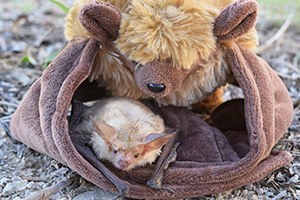Animal Fact Sheet: Western pipistrelle bat |
Identifying Features The Western pipistrelle (Pipistrellus hesperus) is the smallest bat in the United States. Its fur varies from a reddish brown to golden brown on top and a white underside. Its face and ears are black. |
 |
Migration/Hibernation The wintering habits of this bat are not well known. In cooler climates it is thought that they may migrate short distances in order to find a suitable habitat for hibernating. They will hibernate in mines, caves, and rock crevices. |
Habitat The pipistrelle prefers rocky areas such as canyons, cliffs, under loose rocks and caves all in association with water. |
Range These bats can be found from southern Washington through the western United States and to southern Mexico. |
Wild Status This bat is not listed as threatened or endangered at this time. It is one of the most common bats of the desert southwest. |
Diet Pipistrelles are insectivores feeding mostly on small swarming insects like moths, flies, beetles, mosquitoes, and wasps. |
Predators Predators can include owls and possibly other large bat species. |
Reproduction These bats do not form large nurseries or maternity roosts like other bats. Females will share small rock crevices with each other and their pups. The largest maternal colony known was only 12 individuals. She will give birth to one pup sometime during late June or early July. |
Life Span They have a life span of around 10-13 years. |
Size They weigh between 0.1-0.2 oz (3-6 g). Their wingspan is between 7-9 in (19-23 cm). |
Extra Fun-facts
|










